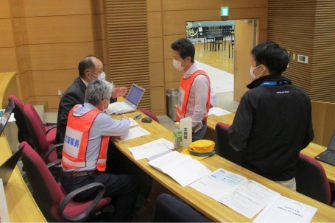Governance
- Basic Philosophy
- Corporate Governance Structure
- Risk and Compliance Management
- Nomination and Compensation Committee
- Reasons for Appointment of Outside Directors, Positions Held Concurrently
- Evaluation of Effectiveness of the Board of Directors
- Compensation for Company Officers
- Cross-Shareholdings Policy
- Dialogue with shareholders and investors
Basic Philosophy
Based on our corporate philosophy of maintaining a global presence, we regard compliance with laws, regulations, and social norms as a fundamental part of our management policies, together with fairness and transparency in our business activities. We also believe these qualities contribute to sustainable corporate development and enhancement of corporate value. Measures to enhance corporate governance, including the establishment of efficient and transparent management organizations, are among our most important management priorities for achieving these objectives. One of the ways in which we enhance corporate governance is by raising compliance awareness among directors, executive officers, and employees of OSG and our group companies through dissemination of the OSG Philosophy and OSG Company Ethics Pledge, which provide specific guidelines designed to raise ethical standards within the company.
Overview of Corporate Governance Structure
Having selected to establish an audit and supervisory committee, OSG's corporate governance structure consists of the Board of Directors, Audit & Supervisory Committee, and accounting auditors. The role of the Board of Directors is clearly defined under this structure. Operational execution functions are performed by executive officers, while the Board of Directors is responsible for decision-making and the supervision of operational execution actions. To strengthen decision-making functions, the seven-member Board of Directors includes two members who are also involved in business operations as executive officers. The remaining five directors, four of whom are outside directors, are also members of the Audit & Supervisory Committee. All of OSG's four outside directors are independent officers as stipulated in the listing rules. With the five members of the Audit & Supervisory Committee, including these highly independent outside directors, also having seats on the Board of Directors, we believe we have put in place a corporate governance structure that verifies and ensures management transparency and appropriateness so as to provide an environment in which management oversight functions effectively.
In addition, OSG has adopted an executive officer system to ensure effective responses to changes in the business environment, as well as to clarify the roles and responsibilities of the executive organization. The executive officers are solely responsible for the performance of business operations in accordance with policies determined by the Board of Directors. They strive to make performance more expeditious and efficient in a timely manner.
Directors' Expertise & Areas of Specialization (Skills Matrix)
| Name | Position and Responsibilities |
Tenure | Independence | Gender | Nomination and Compensation Committee |
General management | Production & technology | Sales / marketing | Financial affairs / accounting | Finance | International affairs | Legal affairs | Risk management | Governance | Diversity |
|---|---|---|---|---|---|---|---|---|---|---|---|---|---|---|---|
| Norio Ishikawa | Chairman & Chief Executive Officer | 21 years | Male | ◯ | ◯ | ◯ | ◯ | ◯ | ◯ | ||||||
| Nobuaki Osawa | President & Chief Operating Officer | 6 years | Male | ◯ | ◯ | ◯ | ◯ | ◯ | |||||||
| Takehiro Tomiyoshi | Director, Audit & Supervisory Committee Member | 3 years | Male | ◯ | ◯ | ◯ | ◯ | ◯ | |||||||
| Akito Takahashi | Outside Director, Audit & Supervisory Committee Member | 7 years | ◯ | Male | ◯chairperson | ◯ | ◯ | ◯ | |||||||
| Kunihiko Hara | Outside Director, Audit & Supervisory Committee Member | 5 years | ◯ | Male | ◯vice-chairperson | ◯ | ◯ | ◯ | ◯ | ||||||
| Kayoko Yamashita | Outside Director, Audit & Supervisory Committee Member | 3 years | ◯ | Female | ◯ | ◯ | ◯ | ◯ | |||||||
| Yoshitsugu Hayashi | Outside Director, Audit & Supervisory Committee Member | 1 years | ◯ | Male | ◯ | ◯ | ◯ | ◯ |
*The chart above does not list all the knowledge and experienced of each
directors, but presents those skills deemed to be representative.
*As of Feb. 21, 2025
Risk and Compliance Management
In addition to measures to improve management transparency and fairness as well as ensure timely information disclosure, OSG has also established Risk Management Rules, which are the framework for creation of risk management structures to maintain management soundness and corporate ethics in the OSG Group. We have also established a Risk and Compliance Management Committee to ensure effective and efficient implementation of the Risk Management Rules. The committee's role is to formulate basic risk management policies, as well as consider and implement timely countermeasures after assessing the significance and urgency of risks.
Compliance Management
Basic Philosophy
The OSG Company Ethics Pledge was established as a set of values and ethics that we thoroughly practice to ensure all directors, executives, and employees at OSG Group companies conduct business activities based on social common sense and comply with laws, regulations, and social standards. The Company Ethics Pledge comprises two sections: business ethics norms and company action standards. Business ethics norms are guidelines establishing the basis upon which business activities should be carried out and how personnel should conduct themselves in order to ensure the prompt and appropriate implementation of fair and appropriate practices.
Company action standards are a detailed code of conduct to ensure the implementation of the business ethics norms.
Promotion of Compliance
Even as we comply with laws, regulations, and other rules, OSG has appropriately maintained and reassessed the OSG Company Ethics Pledge to incorporate training measures when employees are assigned to design, development, or other compliance-related units as part of our training as well as professional education for new employees and others. We have worked to raise our employees' awareness of compliance. Not only do we thoroughly work to uphold conventions such as compliance, adherence, and rule enhancement, but we also strive through training to imbue a sense of pride in our company as well as foster awareness and promote understanding of compliance in each and every one of our employees.
Inernal Reporting System
OSG Group has established internal reporting standards, which provide a mechanism to ensure that reports and consultations are appropriately handled regardless of whether they are received from within the company or without, as concerns organizational or individual violations of laws and regulations in any corporate activity, personal violations of laws and regulations, fraudulent activities, and actions in violation of the OSG Company Ethics Pledge. Upon receipt of a report or consultation from an individual, an investigation team endeavors to discern the facts. If the results of the investigation so dictate, disciplinary provisions in the employment regulations of the relevant OSG Group company are applied, and measures taken to prevent any recurrence. After recurrence prevention measures have been adopted, the director in charge of internal reporting confirms the adopted measures are functioning sufficiently and contributing to strengthening corrective compliance management as well as early detection, in addition to preventing any legal or regulatory violations and protecting the person who came forward with the notification or consultation.
Risk Management
Risk Management Policy
OSG Group strives to ensure the smooth operation of our business by preventing potential risks from arising, responding to risks that do occur, and establishing a system for risk management.
Risks are divided into those associated with the external environment, risks associated with business processes, and risks associated with our internal environment. Risks that management recognizes as likely having a major impact on our financial position, business performance, and cash flow are listed in the table bellow.
Risk Classification
| Risk category | Type of risk |
|---|---|
| External risks | Economic conditions and market trends |
| Trends affecting procurement of raw materials | |
| Climate change, natural disasters, and pandemics | |
| Business process risks | Stable supply to the market |
| Employee working conditions | |
| Safety and health management for employees | |
| Information security | |
| Internal risks | Corporate governance and financial risk |
| Retaining and training human resources | |
| Traffic accidents |
Information Security
<Basic Information Security Policy>
OSG Group has always responded to customer needs, with cutting tools at the core of our business.
In today's highly information-oriented society, we have established a Basic Information Security Policy in order to maintain the trust of our customers and society by protecting information assets from threats such as accidents, natural disasters, and criminal activity as part of our efforts to continue to provide products and services that satisfy our customers' needs moving forward. This policy acts as the basis for our efforts in relation to information security.
- 1. Internal system and information security policy development
- We will establish the management system required to maintain and improve security. Necessary information security measures will be established as formal rules within OSG Group.
- 2. Leadership responsibilities and continuous improvement
- In complying with this policy, OSG Group management will take a leadership role in ensuring the proper management of information assets belonging to OSG Group and our customers.
- 3. Compliance with laws, regulations and contractual obligations
- Senior management and employees at OSG Group companies will comply with the security requirements of all relevant laws, regulations, norms and contractual agreements with customers relating to information assets used in the course of business activities.
- 4. OSG initiatives
- Senior management and employees at OSG Group companies will acquire the knowledge and skills required to maintain and improve information security while ensuring the reliability of our information security initiatives.
- 5. Handling of violations and incidents
- OSG Group will establish a system for responding to information security incidents and any violations of laws, regulations, norms and contractual agreements with customers with relation to information security. Efforts will also be made to reduce the impact of such incidents and violations.
BCP (Business Continuity Plan)
As part of our Business Continuity Plan (BCP), OSG conducts annual drills under the guidance of upper management, while taking into consideration the projected impact on each business site. These drills are based on an estimated earthquake model using the results of a comparison of the impacts of large earthquakes and tsunamis that have repeatedly occurred in the Nankai Trough area in the past.
Furthermore, we are also dedicating effort to preventing workplace injuries, identifying everyday safety risks, and educating employees about safety.
-
1. OSG has formulated a BCP that takes into account an earthquake along the Nankai Trough in the South Sea or Southeast Sea segment (which is an event forecast to occur in the near term), and we conduct training and educational exercises. Moreover, even if a large-scale disaster occurs, a secure living environment with essentials such as water and food is always assured and ready for employees at each business site until a relief system can be established by the municipal or national government.

A first-response drill following the BCP - 2. During times of non-emergency, the Safety and Health Committee, which meets monthly, identifies hazardous work, hazardous equipment, and other such r isks, and strives to mitigate the impact of a natural disaster or human error on production.
Nomination and Compensation Committee
OSG has established a Nomination and Compensation Committee as an advisory body for the Board of Directors. Its purpose is to strengthen the independence, objectivity, and accountability of board functions through the appropriate involvement of independent outside directors and the provision of advice in relation to the appointment of directors and executive officers, etc., and compensation. The Nomination and Compensation Committee consists of directors who are also members of the Audit & Supervisor Committee, and four of the five members are independent outside directors. Persons who are deemed suitable to be directors of OSG, on the basis of their extensive experience, advanced knowledge, and high-level specialist capabilities, are selected and nominated as candidates for membership of the Board of Directors. The Board of Directors then makes decisions on appointments after seeking advice and receiving a response from the Nomination and Compensation Committee.
Please refer to the section headed "Compensation for Company Officers" on the following page for details of OSG's process for determining compensation.
| Name of committee | Total members | Internal directors | Outside directors | Outside experts | Chairperson |
|---|---|---|---|---|---|
| Nomination and Compensation Committee | 5 | 1 | 4 | 0 | Outside directors |
Reasons for Appointment of Outside Directors, Positions Held Concurrently
| Outside director | Audit & Supervisory Committee member |
Reasons for appointment | Positions held concurrently |
|---|---|---|---|
| Akito Takahashi | ○ | Mr. Takahashi has an extensive experience and advanced knowledge and specialist skills gained through his career as an attorney. As a legal expert, he was judged to be a person who would participate in board meetings from an independent perspective and contribute to management auditing and supervision. In addition, he is not associated with any OSG-affiliated company, major supplier or customer. It was deemed that he presents no risk of conflicts of interest with general shareholders. Therefore, the decision was made to appoint him as an outside director. |
|
| Kunihiko Hara | ○ | Mr. Hara has extensive experience as a business executive and academic spanning many years. He was judged to be a person who would participate in board meetings from an independent perspective and contribute to management auditing and supervision. In addition, he is not associated with any OSG-affiliated company, major supplier or customer. It was deemed that he presents no risk of conflicts of interest with general shareholders. Therefore, the decision was made to appoint him as an outside director. |
|
| Kayoko Yamashita | ○ | Ms. Yamashita has extensive experience, advanced knowledge, and specialized skills gained through her career as a certified public accountant. As an expert in accounting and tax affairs, she was judged to be a person who would participate in board meetings from an independent perspective and contribute to corporate management auditing and supervision. In addition, she is not associated with any OSG-affiliated company, major supplier or customer. It was deemed that she presents no risk of conflicts of interest with general shareholders. Therefore, the decision was made to appoint her as an outside director. |
|
| Yoshitsugu Hayashi | ○ | Mr. Hayashi has an extensive experience and broad knowledge acquired over a long academic career. He was judged to be someone who would participate in board meetings from an independent perspective and contribute to corporate management auditing and supervision. In addition, he is not associated with any OSG-affiliated company, major supplier or customer. It was deemed that he presents no risk of conflicts of interest with general shareholders. Therefore, the decision was made to appoint him as an outside director. |
|
*As of Feb. 21, 2025
Evaluation of Effectiveness of the Board of Directors
To enhance the Board of Directors' functions, OSG began conducting analyses and evaluations of the Board's effectiveness in FY2022. To ensure the FY2024 effectiveness evaluation would be objective and transparent, the support of an external organization was secured and the evaluation conducted in September 2024. A session of the Board of Directors was held in November 2024 to analyze, discuss, and evaluate the results. An overview of those evaluation results is given below.
Description
| Targets | All members of the Board of Directors 2 Directors who are not members of the Audit & Supervisory Committee 5 Directors who are members of the Audit & Supervisory Committee (4 of whom are outside directors) for a total of 7 |
|---|---|
| Evaluation method | Anonymous questionnaire |
| Time frame | Response period (Sep. 17 - Oct. 2, 2024) |
| Overview of questions |
|
| Evaluation method | Survey results were consolidated by an external organization and then analyzed, discussed, and evaluated by the Board of Directors |
Evaluation Results
The survey responses gave a favorable evaluation to the manner in which the Board of Directors is expected to operate and its response to those expectations. There is a recognition that the Board of Directors has maintained its effectiveness overall. On the other hand, more in-depth comments were provided about further enhancing support systems, coordination with internal auditing departments, sharing details of dialogues with shareholders and other investors, as well as exchanging views with outside directors. The results shared an awareness that the Board of Directors faces challenges in encouraging discussion and further improving the functions that it exercises.
Initiatives for Enhancing Effectiveness
Once the OSG Board of Directors has taken into consideration this effectiveness evaluation and conducted a sufficient review of the challenges faced, it intends to respond promptly and to continue to further initiatives augmenting its functions. There is a substantial support structure for specific measures addressing challenges that strengthens operational collaboration with executive officers and the secretariat and allows issues to be regularly shared with internal audit divisions. In addition, pertinent details of dialogues with shareholders and investors are shared by personnel handling investor relations.
Compensation for Company Officers
Compensation Structure
Compensation for directors (excluding directors who are members of the Audit & Supervisory Committee) consists of fixed basic compensation, variable compensation linked to business performance, and allocations of restricted stock. Since directors who are members of the Audit & Supervisory Committee are independent from the other directors and are not involved in the execution of business operations, their compensation consists solely of fixed compensation.
Fixed Compensation
The total amount of fixed compensation is determined within the upper limit defined by a resolution of the 103rd Ordinary Shareholders' Meeting held on February 20, 2016. Compensation is set at ¥396 million per year for directors (excluding directors who are members of the Audit & Supervisory Committee), and ¥84 million per year for directors who are also members of the Audit & Supervisory Committee.
Variable Compensation
Starting in the fiscal year ended November 2019, the company provides variable compensation in the form of profit-linked bonuses in line with the definition of profit-linked salaries provided in Article 34, Paragraph 1 Item 3 of the Corporation Tax Act, as well as personal assessment bonuses.
Profit-linked Bonuses
| Eligibility: | Managing directors and eligible directors who are serving as executive officers |
|---|---|
| Calculation method: | Amount of profit-linked bonus = Consolidated operating income X Rank-based bonus standard coefficient (table below) *Maximum of ¥700 million |
Rank-based bonus ratio
| Rank | Chairman, Representative Director | President, Representative Director | Managing Officer |
|---|---|---|---|
| Percentage | 0.3645% | 0.4050% | 0.1620% |
Personal Assessment Bonuses
| Eligibility: | Managing officers |
|---|---|
| Calculation method: | Personal assessment bonuses are paid according to qualitative assessments of each person's contribution to business performance. The maximum amount shall be ¥50 million. |
Compensation Based on Allocations of Restricted Stock
| Eligibility: | Directors (excluding members of the Audit & Supervisory Committee) |
|---|
- The amount of compensation is determined within the upper limit of total compensation determined by resolution of the 106th Ordinary Shareholders' Meeting held on February 16, 2019. The maximum total value of shares allocated to eligible directors (excluding members of the Audit & Supervisory Committee) is set at ¥200 million per year, and the maximum total number of the company's ordinary shares that can be issued or disposed of is 100,000 per year. The purpose of this system is to provide an incentive to achieve continual improvement in the company's performance and corporate value as well as to increase value shared with shareholders.
Process for Determining Compensation
Fixed Compensation, Compensation Based on Allocations of Restricted Stock
In order to determine the amount of compensation for directors (excluding members of the Audit & Supervisory Committee), the Board of Directors delegates the Representative Director to prepare proposed compensation amounts according to standards set by the company. The proposed amounts are then referred to the Nomination and Compensation Committee. Based on the response from the Nomination and Compensation Committee, the amounts are then finalized by a resolution of the Board of Directors. The amount of compensation for directors who are also members of the Audit & Supervisory Committee is determined through consultation among those directors.
Variable Compensation
Variable compensation is linked to the company's business performance. The Representative Director is delegated by the Board of Directors to calculate the proposed amounts for profit-linked bonuses and personal assessment bonuses using the methods outlined above. These proposed amounts are then submitted to the Nomination and Compensation Committee. Based on the report from the Nomination and Compensation Committee, the Board of Directors determines the final amounts to be paid, subject to approval of the total amount by a resolution of the ordinary shareholders' meeting.
The company discontinued payment of retirement bonuses for corporate officers at the conclusion of the 92nd Ordinary Shareholders' Meeting held on February 19, 2005.
Cross-Shareholdings Policy
Reduction in Cross-Shareholdings
The Board of Directors conducts annual reviews to determine whether to continue the practice of cross-shareholdings. Those for which the Board of Directors deems there to be no rationale for their continued holding are gradually sold off. The criteria for such determinations include the purpose of such holdings, risks, and the relationship with OSG.
The cost of capital is also taken into account. As for the exercise of voting rights, the Board of Directors does not make decisions based solely on the short-term performance and share price of the stock of the company held, but comprehensively considers the relationship with OSG in making such determinations.
| FY2020 | FY2021 | FY2022 | FY2023 | FY2024 | |
|---|---|---|---|---|---|
| Number of stocks sold | 0 | 0 | 1(1) | 0 | 2(1) |
| Amount sold | 0 | 0 | 118 | 0 | 28 |
| Book value | 0 | 0 | 20 | 0 | 13 |
| Profit/loss on sale | 0 | 0 | 98 | 0 | 15 |
| Market value held÷Net assets (%) | 4.3 | 3.6 | 3.6 | 4.3 | 6.4 |
Dialogue with shareholders and investors
At OSG, our Strategic Planning Center oversees departments related to investor relations (IR) activities under a structure helmed by our President and COO. Not only do we actively accept IR interviews by phone, small-group meetings, and factory tours among other means, but also semi-annually host President and COO financial results briefings both in person and online to directly explain to people the company's business performance and medium- to long-term efforts.
Instead of just reporting our short-term performance, we repeatedly engage in constructive dialogues with investors and shareholders, focusing on our endeavors for achieving sustainable growth and enhancing corporate value over the mid- to long-term. Incidentally, when having these conversations, we take special care in properly managing insider information.
The opinions and requests we receive through the dialogues are shared at our board of directors' and management meetings. After earnest considerations by our management team, we reflect the feedback in our management policy and specific measures as needed.
| Activity | 2020 | 2021 | 2022 | 2023 | 2024 |
|---|---|---|---|---|---|
| Financial briefings | 2 | 2 | 2 | 2 | 2 |
| Talks with institutional investors and securities analysts | 152 | 142 | 147 | 142 | 160 |
| Those pertaining to ESG | 0 | 2 | 1 | 1 | 0 |
| Overseas investor relations talks | 21 | 16 | 18 | 19 | 23 |
Related content







